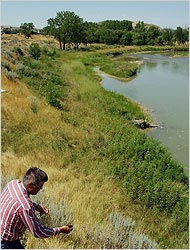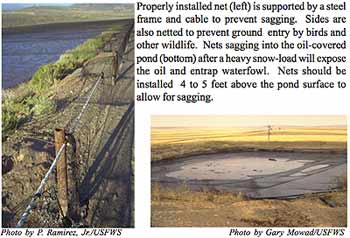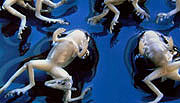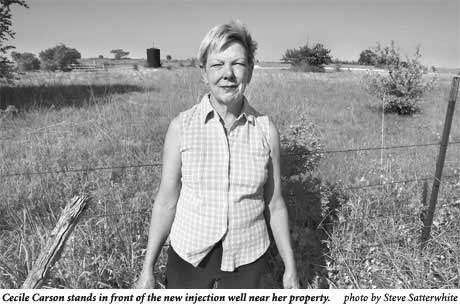Biblio
Workers at a steel mill and a power plant were the first to notice something strange about the Monongahela River last summer. The water that U.S. Steel and Allegheny Energy used to power their plants contained so much salty sediment that it was corroding their machinery. Nearby residents saw something odd, too. Dishwashers were malfunctioning, and plates were coming out with spots that couldn’t easily be rinsed off.
See: Nicholas Kusnetz. "Pennsylvania’s Drilling Wastewater Released to Streams, Some Unaccounted For." ProPublica. Jan. 5, 2011.
See: West Virginia Blue: Dunkard Creek fish kill
See: The Tragedy of the Commons
See: Do the natural gas industry’s surface water withdrawals pose a health risk?
See: Center for Healthy Environments & Communities Homepage
See: The Case for a Truth and Reconciliation Commission on Toxic Hazards
See: Drilling Wastewater Disposal Options in N.Y. Report Have Problems of Their Own - ProPublica
See: Lenape Resources, Inc. | Underground Injection of Wastewater
See: Rulings Restrict Clean Water Act, Foiling E.P.A.
See: Activists Block Entrance to DEP Headquarters, Condemn Failed Enforcement
See: Flow - The War Between Public Health and Private Interests
"Rep. Diane DeGette’s (D-CO) attempt to regulate fracking — underground hydraulic fracturing for natural gas extraction — is under attack by a multimillion-dollar lobbying and public-relations campaign from the oil and gas industry. Led by the American Petroleum Institute and the Independent Petroleum Association of America, dozens of industry organizations established the Energy in Depth front group to denounce fracking legislation as an “unnecessary financial burden on a single small-business industry, American oil and natural gas producers.”
See: Lee Fuller. "HF 101: As Cornell Begins Study of Shale Gas Exploration, Energy In Depth Offers Itself Up as Resource for Ad Hoc Panel". Energy in Depth.
It's really hard for me to read about the Dunkard Creek fish kill without getting very angry.
An ecosystem has been destroyed.
...the 38-mile creek is all but dead, its 161 species of fish, mussels, salamanders, crayfish and aquatic insects killed by mysterious pollutants coming from sources state and federal agencies have yet to pinpoint despite aggressive field work.
The investigation thus far indicates the most likely cause as oil and gas drilling wastewater. (There's more ability to generate wastewater from the Marcellus Shale drilling than there are wastewater treatment facilities in the area, so the incentive for rogue wastewater disposal is high.)
West Virginia Community Blog. The Best Blogging Community in West Virginia. Democratic politics, progressive policies, the good life and free living in Wild, Wonderful West Virginia.
A federal judge has overturned water quality rules that were meant to protect southeastern Montana cropland from natural gas drilling but were assailed by Wyoming as a threat to energy production.
The rules covered the Tongue and Powder rivers, which flow north from the rich gas fields of northeastern Wyoming into primarily agricultural land in Montana.
Drafted by Montana and approved by the Environmental Protection Agency, the rules limited how much salty water - a byproduct of drilling - could enter the rivers. State officials said the EPA had not yet begun to enforce the rules, in part because of a pending lawsuit.
In a judgment in that case issued Tuesday, U.S. District Judge Clarence Brimmer in Cheyenne, Wyo., annulled the rules and sent them back to the EPA to reconsider. Brimmer wrote that the EPA had failed to give the water quality standards a full review when it approved them in 2003 and 2008.
The lawsuit has pitted natural gas companies backed by the state of Wyoming against the EPA and Montana.
The case represents one of several running skirmishes between Montana and Wyoming over the rivers that flow north across their shared border.
The quality of drinking water is an urgent concern for over forty million people who live in proximity to the Marcellus Shale.
"The 35-year-old federal law regulating tap water is so out of date that the water Americans drink can pose what scientists say are serious health risks — and still be legal.
Only 91 contaminants are regulated by the Safe Drinking Water Act, yet more than 60,000 chemicals are used within the United States, according to Environmental Protection Agency estimates. Government and independent scientists have scrutinized thousands of those chemicals in recent decades, and identified hundreds associated with a risk of cancer and other diseases at small concentrations in drinking water, according to an analysis of government records by The New York Times.
But not one chemical has been added to the list of those regulated by the Safe Drinking Water Act since 2000.
Other recent studies have found that even some chemicals regulated by that law pose risks at much smaller concentrations than previously known. However, many of the act’s standards for those chemicals have not been updated since the 1980s, and some remain essentially unchanged since the law was passed in 1974."
More than three decades after the Clean Water Act, iconic American waterways like the Chesapeake Bay and Puget Sound are in perilous condition and facing new sources of contamination.
With polluted runoff still flowing in from industry, agriculture and massive suburban development, scientists note that many new pollutants and toxins from modern everyday life are already being found in the drinking water of millions of people across the country and pose a threat to fish, wildlife and, potentially, human health.
In Poisoned Waters, Pulitzer Prize-winning journalist Hedrick Smith examines the growing hazards to human health and the ecosystem...
...In addition to assessing the scope of America's polluted-water problem, Poisoned Waters highlights several cases in which grassroots citizens' groups succeeded in effecting environmental change: In South Park, Wash., incensed residents pushed for better cleanup of PCB contamination that remained from an old asphalt plant. In Loudon County, Va., residents prevented a large-scale housing development that would have overwhelmed already-strained stormwater systems believed to contribute to the contamination in Chesapeake Bay.
See Credits.
The New York-based Toxics Targeting went through the Department of Environmental Conservation’s own database of hazardous substances spills over the past thirty years.
They found 270 cases documenting fires, explosions, wastewater spills, well contamination and ecological damage related to gas drilling.
Derrick Ek. "Gas drilling concerns aired at DEC hearing," Nov 19, 2009. Corning Leader.
Ithaca environmental activist Walter Hang details a history of problems caused by the oil and gas industry in New York State.
Cecile Carson's property has an aura of rural homeyness. The neat yard, happy dogs, and blooming flowers along her fence rails suggest a love of place.
She's a high school art teacher who picked a little swath of Wise County near the small town of Decatur, about 35 miles north of Fort Worth, to settle down. She lived in a travel trailer for the first three years while she designed and built her home. The place is well thought out—its colors blend with the surrounding landscape of green, rolling hills.
It took Carson 10 years to get to this point. But it took the Railroad Commission of Texas about 45 seconds to put it all in jeopardy. On April 11, at an administrative hearing in Austin, it took less than a minute for a public reading of Carson's and her neighbor's protests against the placement of an oilfield waste injection well just a few hundred feet from their property.
Then the three commissioners immediately voted "denied" without discussion...
...Part of the commission's enforcement problem is a lack of effective penalties. After the commission field staff goes through an elaborate protocol of voluntary compliance with an offending operator, the inspector must dot every "i" and cross every "t" in order to file a legal enforcement package that will, at most, result in a fine of between $500 and $3,500.
Jim Robbins. September 10, 2006. New York Times.
It is a strange fight, Montana ranchers say. Raising cattle here in the parched American outback of eastern Montana and Wyoming has always been a battle to find enough water.
Now there is more than enough water, but the wrong kind, they say, and they are fighting to keep it out of the river.
Mark Fix is a family rancher whose cattle operation depends on water from the Tongue River. Mr. Fix diverts about 2,000 gallons per minute of clear water in the summer to transform a dry river bottom into several emerald green fields of alfalfa, an oasis on dry rangeland. Three crops of hay each year enable him to cut it, bale it and feed it to his cattle during the long winter.
“Water means a guaranteed hay crop,” Mr. Fix said.
But the search for a type of natural gas called coal bed methane has come to this part of the world in a big way. The gas is found in subterranean coal, and companies are pumping water out of the coal and stripping the gas mixed with it. Once the gas is out, the huge volumes of water become waste in a region that gets less than 12 inches of rain a year.

Mark Fix, a cattle rancher in eastern Montana, diverts about 2,000 gallons per minute of Tongue River water in the summer to grow hay for his livestock. But increased sodium in the water could endanger his hayfields.
See: Molly Ivins. (2004) C-Span Book TV Oct. 2, 2004. Bushwacked: Life in George W. Bush's America. Chapter: "Dick, Dubya, and Wyoming Methane." (152)
Pedro Ramirez, Jr. "Wildlife Mortality Risk in Oil Field Waste Pits." U.S. Fish and Wildlife Service. Environmental Contaminants Specialist.

The risk that oil pits pose to wildlife has been documented by several studies. Hydrofracking involves the storage of "frack water" in open pits.


See: TxSharon (2009). Video. "Cattle Drink Drilling Waste."
See: Robert Myers (2010). Environmental Dangers of Hydro-Fracturing.
See: Laura Legere (2010). Hazards posed by natural gas drilling are not limited to below ground.
See: Pit Pollution.
See: Powder River Basin Resource Council
See: Rancho Los Malulos | A satirical view from the McGill Brothers Lease
See: Ecological integrity of streams related to human cancer mortality rates
- « first
- ‹ previous
- 1
- 2
- 3



















